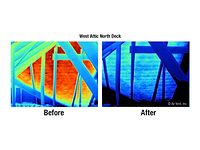
Every artist — no matter what the trade — likes to break from the commercial norm and dabble into an area where personal aesthetic interests can be met. Carter Watkins Associate Architects, Monroe, Ga., and Johns & Kirksey Inc., Tuscaloosa, La., decided that a historic courthouse would be a chance to showcase some unique skills.
The Madison County Courthouse in Danielsville, Ga., was in dire need of repair and maintenance throughout its body. Both interior and exterior work were needed for the 99-year-old building. Having researched both the original architect and contractor, J.W. Golucke and Fred Wagner, respectively, Ben Carter of Carter Watkins, wanted to help preserve its original features. Since the county had voted to restore the roof using tax dollars, it was allowed to decide what colors and features of historic codes to use. But where does one find a local contractor who repairs and installs “old-style tin roofs” in Dixieland?
Bill Johns had read of the courthouse in the Dodge Reports. He placed one of the two bids and found a new home for the next three months. “We placed a ‘hard-bid’: The job was published for anybody to bid,” say Johns from his office. “If you are the low bidder and qualified to do the job, you get the contract.” His company, Johns & Kirksey Inc., usually repairs metal roofs, but terne-coated steel — that’s a different avenue, one that the firm would like to do more of.
Prepping the project consisted of scaffolding the entire courthouse (the tower was 66 feet, the roof 36 feet), so the job could be operated in a safe and stable manner. Since the crew of seven was given access to the inside of the establishment as well, easy entry/exit made the transferring of equipment and material easier. The scope of the job included repairing the decking, chimneys and metal soffit, and replacing all the terne metal.
“We replaced the original, traditional standing seam roof with almost the exact same roof,” states Johns. “Follansbee has been making the original roof for over 200 years. The new roof is 28-gauge Terne II, also manufactured by Follansbee.” Asked if Follansbee was preferred, the contractor added that each project calls for different material, but that Follansbee is still making the same roof that it was making back in 1901. Although using the same brand and type of stock, the Follansbee material didn’t make the project any easier.
“The lead-tin coating has recently been replaced with a zinc-tin coating, which makes it less hazardous but harder to work with,” says Johns. “The material comes in 20-inch by 50-foot rolls. It is field formed to make the double-rolled standing seams by using a 10-foot brake or hand tongs, seaming iron and mallet. All the ridges and hip connections are made by double folding the ends of the adjoining panels together like a standing seam with the hand tongs, seaming iron and mallet.”
This was all done on top of the courthouse, seam by seam, piece by piece.
Justifiably, Madison County wanted to keep the color red. At least red is thought to have been the original color. “Most of Golucke’s designs were in red, and the back side of the materials removed were red, so we can only assume this was the color intended,” states Carter.
Once the roofing was installed, it was primed and painted with two coats of Follansbee RapidDri paint. Johns’ philosophy on consistent applications of paint is very simple: “With regular painting, this new roof should last longer than the original roof. Regular meaning every five to 10 years — it will last forever.”
It might seem that the hand-made, double-folded seams and the painting and priming would have been the grueling tasks of this project. But the detailed flashing and gutter system were the real back-breakers. “There was a chimney in almost every valley,” adds Johns. “The flashing is soldered, very difficult. It’s a poor design to put the chimney there — whether the designer thinks of it or not, it’s left to the roofer to take care of it, to solder all joints together to make it watertight. The gutters, they must’ve been 3 feet wide.”
If you had a topographic view of the courthouse from an aerial transit, you would marvel at the roof and its complex geometric layout, chock full of valleys, ridges, etc. But it doesn’t take an elevated perspective to appreciate the final outcome. The contractors fulfilled their part in delivering a beautiful and honest interpretation of the original conception. Carter agrees that Johns & Kirksey was easy to work with and hopes to collaborate with the company again.
It only takes a scan at the company’s Website, www.johnskirksey.com, to convince you of the team’s aesthetic capabilities and consistent quota of quality. However, Johns is no grandstander; he’ll let the final result speak for itself. Reflecting on the Madison County Courthouse he concludes, “I enjoy doing this type of work as it is the classic metal roof and is rarely used in this part of the country. It gives our guys the chance to show off some craftsmanship in their work.”





